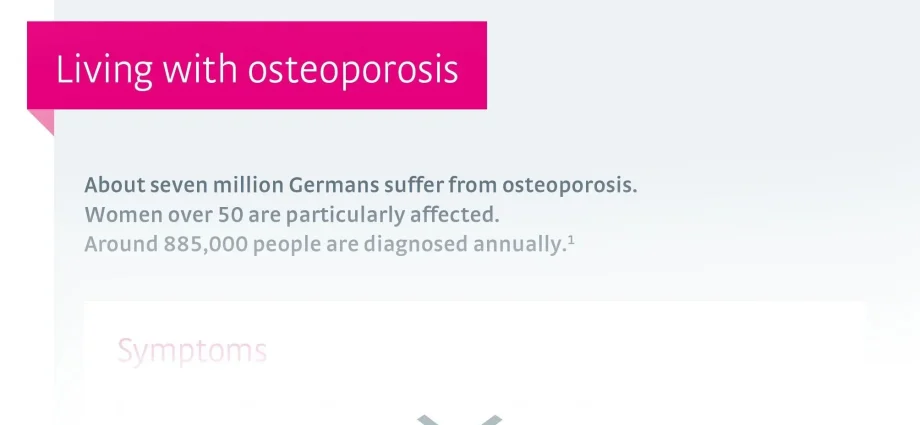Contents
Osteoporosis is a disease that will occur with increasing frequency in industrialized countries, including Poland. It is related to the phenomenon of progressive aging of the society. Advanced loss of bone mass is manifested by fractures mainly in women over 50 years of age. Few, however, are aware of the fact that osteoporosis develops over the years, and the risk increases in people who lead an unhygienic lifestyle, including those who use an inappropriate diet, avoid physical activity and are addicted to alcohol and nicotine.
In Poland, about 7% of people suffer from osteoporosis. It is estimated that this number will increase. With age, there is a gradual loss of bone mineral density, which is an irreversible process. The good news, however, is that by leading an appropriate lifestyle, you can realistically reduce the risk of extensive bone loss, and thus osteoporotic fractures.
The development of osteoporosis is accelerated by, among others:
- a diet low in calcium, phosphorus, magnesium, and vitamin D,
- low physical activity,
- excessive alcohol consumption,
- little exposure to solar radiation.
Bad diet
Diet is an important factor that greatly influences the bone demineralization process and rate. It is especially dangerous to eat too much salt, which contributes to increasing the excretion of calcium in the urine. It is also a bad eating habit to include highly processed products (e.g. fast food) and sweets in the daily menu. These products have negligible nutritional value, and at the same time high in calories, which negatively affects not only the condition of the bones, but also the entire body.
So what to eat to strengthen bones every day? The conscious consumer should include, among others, dairy products (milk, yoghurt, kefir, cheese, cottage cheese), fish (mainly mackerel, herring, sardines, salmon), legumes (soybeans, beans, lentils), eggs, nuts, and green leafy plants.
Adequate supplementation is also crucial, mainly in seniors, in whom the degree of calcium absorption from the gastrointestinal tract is much lower than in young people. Pregnant and breastfeeding women should also be included in the prophylaxis. Calperos is a good choice as it contains calcium ions in the form of calcium carbonate.
Stimulants – alcohol and smoking
It is widely known that nicotine and alcohol contribute to the occurrence of many diseases, including the lungs and cardiovascular system. Scientists in Philadelphia and New York have recently shown that these popular drugs impair the physiological functioning of the immune system, resulting in an overproduction of osteoclasts that contribute to the dissolution of bone tissue. Other studies only confirm the destructive effect of tobacco on bone density. It has been shown that smokers have a 30-40% increase in the risk of hip fractures.
Low physical activity
People who lead a sedentary lifestyle are primarily exposed to the development of osteoporosis. Osteopenia, which is a disease that precedes osteoporosis, appears at a young age, incl. due to lack of physical activity. The bone is then insufficiently mineralized. Moreover, the lack of exercise contributes to weight gain, which puts a lot of strain on the skeleton.
The World Health Organization (WHO) emphasizes that daily exercise not only protects against bone loss, but is also recommended in people who have already been diagnosed with osteoporosis. In the latter case, however, it is worth remembering about the appropriate selection of exercises and performing them under the supervision of an experienced physiotherapist or trainer. Systematic movement improves coordination and posture, increases bone mineralization, and strengthens the entire musculoskeletal system.
Insufficient exposure to sunlight
Vitamin D levels decrease with age. It is worth noting that this compound plays an important role in bone transformation, and its deficiency is one of the factors in the development of osteoporosis. The main source of this prohormone is cutaneous synthesis under the influence of solar radiation.
In Poland, due to its geographical location, optimal exposure to the sun is not possible for most of the year. It also significantly decreases in the elderly, mainly in those experiencing physical disabilities. Therefore, it is necessary to supplement vitamin D and supply it with food (dairy products, fish oil, eggs).
Strong bones should be taken care of from an early age. The implementation of healthy habits, including a diet rich in vitamins and minerals, daily physical activity and the abandonment of harmful stimulants, significantly reduces the risk of developing osteopenia and osteoporosis. Physical fitness is one of the elements that determine the quality of life, especially in seniors.










